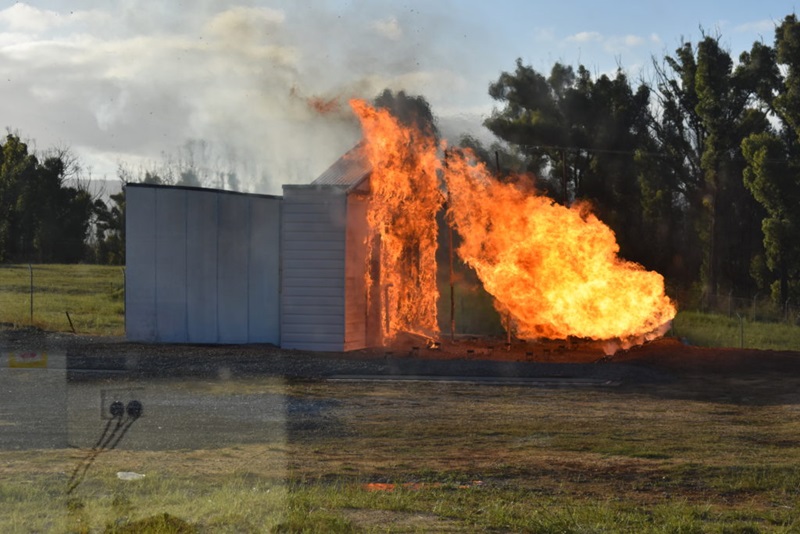We've all seen the cliché of the movie hero waking away from the exploding building. Justin Leonard's work is arguably more exciting than any action film. Justin leads our research into bushfire adaptation. Bushfire adaptation research investigates how to manage the risk of bushfires to Australian homes and lives. Australia is a country that already has a variable climate. More frequent and severe extreme events under climate change means action must be taken. Justin gives us insights into how his research is creating a future where our homes are resilient to fire.
Claim to flame
Justin has worked with CSIRO for 27 years on fire research, 24 of these focussed specifically on bushfires. His passion is to help Australians remain living in their dream home, in their dream location, for the long term.
Justin studies how bushfires interact with structures and how people perceive risk. He’s been burning things at the Mogo Bushfire Burnover Facility in southern NSW for more than 18 years and has been a part of at least 45 ‘burnovers’.
A burnover is when a fire moves through an area covering whatever is in its path. Burnover simulations can involve infrastructure such as buildings, fire trucks, fences, power poles and water tanks. Justin and his team use the fire simulation to test their resilience. This includes how well they cope with heat radiation and flames. Using heat sensors, they can track the levels at which different aspects fail.
What fuels Justin
Justin studied engineering at the University of Melbourne. In these early years, he was focussed on automotive research looking into sustainable transport and alternative fuels. Justin's early work led him to CSIRO as a technical officer in the fire science team. “This essentially started my apprenticeship in fire, and then I specialised in bushfire,” he said.
He was initially involved in researching how different materials respond to fire, including materials used in transport, military equipment and buildings. Since then, he's worked on many projects to better understand how fire moves through a landscape, how infrastructure responds to fires, and how we can enable our built world and fire to co-exist.
Justin’s average day doesn’t involve burning down houses. He spends most of his time analysing data and writing up findings from his desk. “My kids would describe my standard day as staring at a computer, typing and occasionally talking to someone,” Justin said.
But it’s exceptionally important computer work. Through his research, Justin aims for Australians to coexist safely with bushfires and to be able to build their homes in a way that is resilient to extreme events, while still enjoying the natural landscape of Australia.

Blazing a trail
Justin’s most satisfying project yet has been the One House project. One House is a prototype house created by Suncorp and designed in collaboration with James Cook University and Room 11 Architects.
“It’s a unique project because it is the first time that research considered how to make a house that could withstand a variety of extreme weather events – flood, storm, cyclone and fire,” Justin said.
The house’s materials are designed to be resilient to water, wind and fire. This includes using steel framing, cladding and roof sheeting, durable insulation, aerated concrete panels and a concrete slab. A screening system extending beyond the deck gave the house an initial barrier, particularly to heat and flames.
“We burnt a 12-metre wide fire front which approached the house and were very please to find that the house’s design responded well,” he said. “It was a really positive result. Multi-hazard resilience has a big future.”
Remaining comparative to the cost of any standard architecturally designed home built today, the One House design uses materials and features seen in most Australian homes, however incorporates design principles to dramatically increase the resilience of the structure.
“These houses are designed to last for much longer than the average Australian house. While some elements may add additional cost to the build, the end outcome is a more durable and more energy-efficient house, regardless of whether a fire ever comes.”
Many irons in the fire
Justin’s previous research has already had a major impact on managing fire risk. He has studied a number of systems to help fire fighter crews survive a burnover in their trucks:
- window curtains – that protect cabin members by shielding windows from radiant heat and add another layer of protection in case the windows break
- water spray systems – that create a film of water on surfaces that need protection, such as the cabin, wheels and pumping system
- fire resistant covers – that protect the truck’s electrics, pumps, air intakes and hoses.
Justin said this kind of technology and especially multi-hazard resilience, like the One House design, was an increasingly important research area, especially under a changing climate.
“If people want to continue living in the Australian landscape they are going to have to adapt. Better to do it now before the next extreme event,” he said.
Justin and his team will continue to focus on resilient design principles and wider applications. He said that while we need to accept the risk of bushfires, the aim of his work is to help Australians live with the threat of bushfires without feeling powerless.
